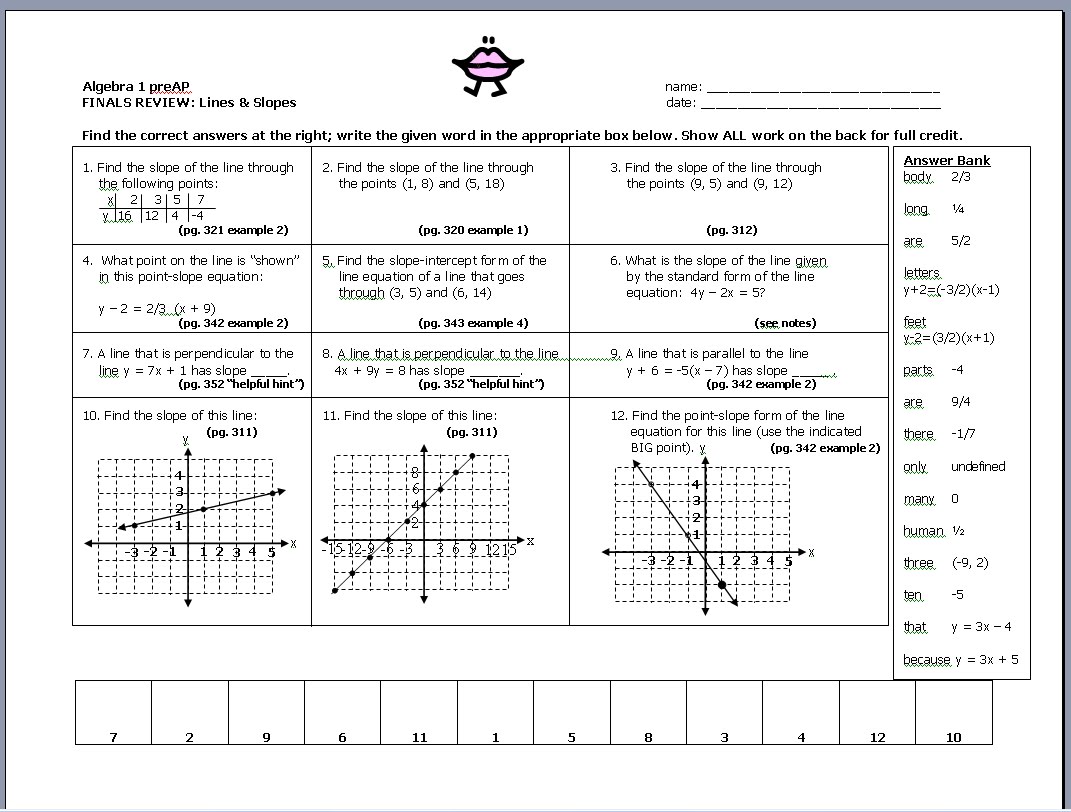Imagine you’re navigating a winding mountain road. You wouldn’t just blindly follow the curves, right? You’d need a map, a compass, maybe even a trusty guide to understand the road’s twists and turns. Now, imagine that road is the graph of a line in math. The slope is your compass, guiding you through its direction and steepness, helping you understand the relationship between two variables. This is the heart of 3 3 skills practice on slopes of lines—it’s about mastering those guiding principles and becoming a champion of linear equations.

Image: mathteachermambo.blogspot.com
Understanding slopes is a fundamental skill in algebra, impacting everything from analyzing data to predicting trends. It’s the key to unlocking a whole world of mathematical insights, from calculating the rate of change in distance to understanding the relationship between profit and production. So, let’s embark on a journey to conquer the 3 3 skills practice, mastering the secrets of slopes, and becoming a confident explorer of linear equations.
The Slope Formula: Your Guide to the Gradient
The foundation of understanding slopes lies in the slope formula:
- Slope (m) = (Change in Y) / (Change in X)
This formula encapsulates the very essence of a slope: how much the line rises or falls for every unit it moves horizontally. To visualize this, imagine a staircase. Each step represents a change in Y (the vertical rise), and the distance between steps represents a change in X (the horizontal run). The slope, essentially, is the ratio of rise to run, telling us how “steep” the staircase is.
Deciphering the Signs: A Compass for Lines
The sign of the slope provides crucial information about the line’s direction:
- Positive Slope: The line rises from left to right (Think of a hill you’d climb).
- Negative Slope: The line falls from left to right (Think of descending down a mountain).
Let’s bring this concept to life with a real-world example. Imagine you’re driving along a straight road. The speed limit is your slope. If the speed limit is positive (say, 60 mph), you’re moving forward and covering ground. But if the speed limit is negative, you’d be moving backward or going downhill. The slope’s sign dictates the direction of change.
Mastering 3 3 Skills Practice: The Journey Begins
The 3 3 skills practice problems provide a playground for honing your understanding of slopes. They offer a guided path to becoming a master of linear equations. Here’s how to navigate these practice exercises:
- Step 1: Identify the Points: The practice problems often give you two points on the line. These points provide you with the coordinates (x1, y1) and (x2, y2) needed to calculate the slope.
- Step 2: Apply the Formula: Plug the coordinates into the slope formula (m = (y2 – y1) / (x2 – x1)). Remember, the order matters when subtracting the coordinates!
- Step 3: Calculate the Slope: Simplify the expression to find the numerical value of the slope.
- Step 4: Interpret the Slope: Analyze the sign and magnitude of the slope to understand the steepness and direction of the line.

Image: gustavogargiulo.com
Beyond the Basics: Unveiling the Secrets of Different Forms
We’ve learned about the slope formula, but linear equations can be expressed in different forms:
- Slope-Intercept Form: y = mx + b, where ‘m’ is the slope and ‘b’ is the y-intercept (the point where the line crosses the y-axis). This form is especially helpful for easily identifying the slope and y-intercept of a line.
- Point-Slope Form: y – y1 = m(x – x1), where ‘m’ is the slope and (x1, y1) is a point on the line. This form is handy when you already know the slope and a point on the line.
- Standard Form: Ax + By = C, where A, B, and C are constants. While the slope isn’t immediately clear, you can rearrange the equation into slope-intercept form to find it.
Unlocking the Power of Linear Equations: Real-World Applications
The 3 3 skills practice isn’t just about memorizing formulas; it’s about understanding their real-world applications. Here’s how slopes come into play in various fields:
- Economics: Business owners use slopes to analyze cost and revenue functions, determining profitability and optimizing production.
- Physics: Slopes help understand the relationship between force, mass, and acceleration in the study of motion.
- Data Analysis: Data scientists use slopes to determine trends and patterns in data sets, uncovering insights from numerical information.
- Engineering: Engineers apply slopes to design structures, optimizing stability and resistance to forces.
Building Confidence with Expert Insights
The key to mastering slopes is not just understanding the formulas but also building a deep intuition for their meaning. Here are some expert insights to guide your journey:
- Visualize the Line: Whenever you work with slopes, try to visualize the line in your mind. This makes understanding the direction and steepness of the line much clearer.
- Connect the Dots: Recognize that the slope represents the rate of change between any two points on the line. This helps you understand how the line behaves.
- Embrace Practice: The more you practice, the more intuitive your understanding of slopes becomes. The 3 3 skills practice problems are your stepping stones to mastery.
3 3 Skills Practice Slopes Of Lines Answers
Conclusion: Stepping Forward with a New Perspective
As we conclude our exploration of slopes, remember that the 3 3 skills practice is not just about finding answers; it’s about developing a strong foundation in linear equations. This foundation will empower you to solve complex problems, analyze trends, and interpret data with confidence. So, keep practicing, keep exploring, and remember that the world of slopes is waiting to be unveiled.





